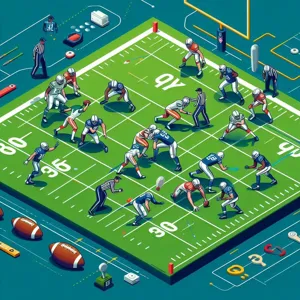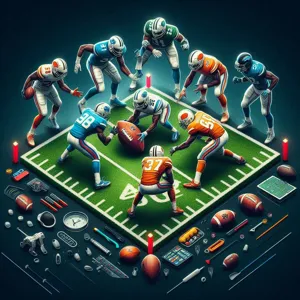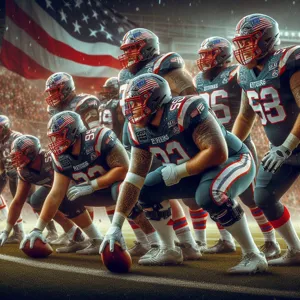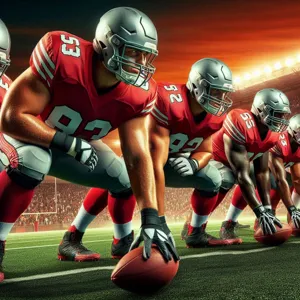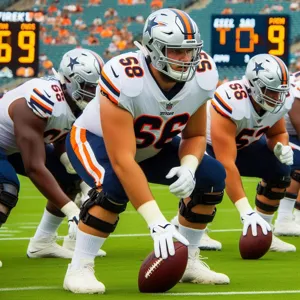In the high-octane world of American football, where the clash of titans on the field is matched only by the relentless pursuit of victory, the use of performance-enhancing drugs (PEDs) has emerged as a controversial and pressing ethical dilemma.
As athletes push their bodies to the limit, the temptation to gain a competitive edge through substances that promise enhanced strength, speed, and endurance looms large, raising questions about fairness, integrity, and the very essence of the sport. This blog post delves into the murky waters of PED use in football, exploring the ethical implications faced by players, coaches, and the league itself. From the pressure to perform at extraordinary levels to the health consequences and the impact on the game’s legacy, we will navigate the complexities of this contentious issue and challenge readers to consider where the line should be drawn in the quest for excellence. Join us as we examine the ethical dilemmas surrounding performance-enhancing drugs in American football, a topic that continues to spark debate among players, fans, and policymakers alike.
1. Introduction to Performance-Enhancing Drugs (PEDs) in Sports

In the high-stakes world of American football, the quest for athletic excellence often intersects with the controversial realm of performance-enhancing drugs (PEDs). These substances, ranging from anabolic steroids to stimulants, have been utilized by athletes in various sports for decades, aiming to amplify strength, endurance, and recovery. The allure of breaking records and achieving peak performance can tempt players at every level, from high school hopefuls to seasoned professionals. However, the implications of using PEDs extend far beyond the gridiron, raising profound ethical questions that challenge the integrity of the sport itself.
As we delve into the complexities surrounding PEDs in American football, it is essential to understand both the reasons athletes might turn to these substances and the potential consequences they face—not only in terms of health risks but also regarding their careers and reputations. The NFL, along with various governing bodies, has established strict policies and testing protocols aimed at curbing drug use and promoting fair competition. Yet, the persistent prevalence of doping scandals suggests that the struggle between ambition and ethics continues unabated.
This introduction serves as a gateway into a broader discussion about the ethical dilemmas posed by PEDs in football. We will explore the motivations behind their use, the impact on player health and safety, and the ongoing debate about fairness in competition. As we navigate this intricate landscape, we invite you to consider the question: At what cost does the pursuit of excellence come, and what does it mean for the future of American football?
2. The History of PED Use in American Football
The history of performance-enhancing drug (PED) use in American football is a complex tapestry woven from ambition, desperation, and the relentless pursuit of excellence. The roots of PED use in the sport can be traced back to the mid-20th century, when the pressures of competition began to mount, and athletes sought any means necessary to gain an edge. In the 1960s, amphetamines, commonly referred to as “greenies,” became popular among players, providing a quick boost in energy and focus, allowing athletes to push through fatigue during grueling games and intense training sessions.
As the decades progressed, the landscape of PED usage evolved. The 1980s and 1990s heralded the rise of anabolic steroids, substances that promised increased muscle mass and strength. Players, motivated by the desire to enhance their performance and secure lucrative contracts, began to push the boundaries of acceptable training regimens. This era saw a notable shift in the culture of the sport, as the physical demands of the game grew, and the line between natural athleticism and artificially augmented performance began to blur.
The NFL’s response to the growing PED crisis has been tumultuous. Initially, the league adopted a laissez-faire attitude, with minimal testing and vague regulations. However, as public scrutiny intensified and high-profile cases of doping surfaced, the NFL was compelled to implement stricter policies. In 1980, the league introduced its first drug-testing program, which has since evolved into a comprehensive system aimed at deterring use and promoting player safety.
Despite these efforts, the cat-and-mouse game between players seeking an advantage and league officials enforcing regulations continues to this day. The advent of designer steroids and new substances that evade testing methods has kept the issue at the forefront of discussions about the integrity of the sport. High-profile scandals, such as the case of players like Ray Lewis and Tom Brady, have underscored the ethical dilemmas surrounding PED use, raising questions about fairness, health implications, and the very essence of competition.
As we navigate through this intricate history, it’s crucial to understand that the conversation surrounding PEDs in American football is not merely about breaking the rules; it’s also about the societal pressures athletes face and the lengths they will go to in order to fulfill their dreams. This ongoing saga reflects broader themes of ambition, ethics, and the relentless pursuit of greatness, making it a fascinating yet troubling aspect of the sport’s legacy.
3. Defining Ethical Dilemmas in Sports

In the world of sports, ethical dilemmas often arise from the complex interplay between competition, integrity, and the well-being of athletes. Specifically in American football, the use of performance-enhancing drugs (PEDs) presents a multifaceted ethical quandary that challenges traditional notions of fairness and sportsmanship. At its core, the ethical dilemmas surrounding PEDs hinge on two primary questions: Is it justifiable for athletes to use substances to improve their performance, and what are the implications of such choices on the sport as a whole?
On one hand, proponents argue that athletes should be free to pursue every possible advantage in a fiercely competitive landscape. They assert that if athletes are willing to assume the risks associated with PED use—ranging from health complications to potential bans—then they should have the autonomy to make that choice. This perspective presents a libertarian viewpoint on personal responsibility, suggesting that the pressure to perform at peak levels may compel players to seek out these substances, often as a means of survival in a high-stakes environment.
Conversely, critics of PEDs highlight the inherent unfairness and potential harm these substances bring to the sport. The use of enhancements can create a false sense of competition, wherein athletes who refrain from doping are at a distinct disadvantage. This raises serious ethical concerns about the integrity of the game and the message sent to young athletes who idolize professional players. Furthermore, the health risks associated with long-term PED use—such as cardiovascular disease, hormonal imbalances, and psychological issues—present a troubling dichotomy between the pursuit of excellence and the preservation of athlete welfare.
In this landscape of ethical dilemmas, it is essential to consider the broader implications of PED use in American football. The rampant use of these substances not only tarnishes the legacy of the sport but also sets a dangerous precedent for future generations of athletes. As stakeholders—including players, coaches, and fans—grapple with these complex issues, it becomes increasingly clear that the conversation surrounding performance-enhancing drugs must extend beyond individual choice to encompass the ethical responsibilities we hold to preserve the integrity of the game itself.
4. The Pressure to Perform: Athletes and Expectations
In the high-stakes world of American football, athletes are often thrust into a pressure cooker of expectations, driven not only by their personal ambitions but also by the demands of coaches, fans, and sponsors. The quest for excellence is relentless, with players expected to push their physical limits week after week. In this environment, the allure of performance-enhancing drugs (PEDs) becomes increasingly tempting.
From a young age, athletes are groomed to excel, facing scrutiny at every turn. The weight of expectations can be overwhelming, as a single injury or dip in performance can jeopardize a player’s career and earning potential. The fear of being benched or replaced by a younger, more promising talent looms large, creating an intense pressure to maintain peak performance. This atmosphere not only fosters a culture of competition but also cultivates an environment where the use of PEDs can seem like a necessary evil.
Moreover, the athletic community often glorifies extraordinary feats of strength and endurance, setting unrealistic benchmarks for what it means to be a ‘top performer.’ media coverage, fan engagement, and the lucrative nature of endorsements further amplify this narrative, leaving athletes caught in a web of expectation. Many players may rationalize the use of PEDs as a means to meet these demands, believing that the risks are outweighed by the potential rewards of success—be it a championship ring, a multi-million dollar contract, or a spot in the Hall of Fame.
As the conversation around PEDs continues to evolve, it is crucial to examine the underlying pressures that drive athletes to these ethical dilemmas. The reality is that the competitive nature of football, combined with societal expectations, creates a perfect storm where the line between fair play and enhanced performance becomes increasingly blurred. Athletes must navigate not only their personal aspirations but also the complex moral landscape shaped by the pursuit of glory in a sport that often prioritizes winning above all else.
5. The Role of Coaches and Management in PED Use

In the high-stakes world of American football, coaches and management play a pivotal role in shaping the culture and ethics surrounding performance-enhancing drugs (PEDs). The pressure to win, both for personal glory and lucrative contracts, can create an environment where the temptation to turn a blind eye to PED use becomes increasingly strong. Coaches, often seen as authority figures and mentors, wield significant influence over their players. Their attitudes towards PEDs can either discourage their use or inadvertently endorse it, depending on how they prioritize victory over integrity.
Management, including general managers and team owners, also contribute to this complex dynamic. The desire for immediate success can lead to a win-at-all-costs mentality, fostering an atmosphere where players may feel compelled to enhance their performance, sometimes at the expense of their health. While some organizations have robust policies in place to combat PED use, others may lack the necessary framework or commitment to enforcement, allowing a culture of silence to thrive.
Moreover, the consequences of PED use extend beyond the individual player; they ripple through the entire team and organization. A coach’s choice to overlook these practices can lead to short-term gains, but it often leaves long-lasting scars on team morale and the integrity of the sport. As fans, we must ask ourselves: Are we willing to accept a culture that prioritizes winning over the well-being of the athletes who entertain us? The dilemma lies not only in the actions of players but equally in the ethical responsibilities of those who lead them.
In this intricate dance between ambition and ethics, coaches and management must navigate their roles carefully, understanding that their decisions can define the future of the sport and the legacy of the athletes they guide.
6. Health Risks and Consequences of PEDs
The allure of performance-enhancing drugs (PEDs) in American football is undeniable, particularly for athletes eager to gain a competitive edge. However, the health risks and consequences associated with these substances are profound and often catastrophic. Players may initially be drawn to PEDs for the promise of increased strength, endurance, and recovery. Yet, what often follows is a grim reality that starkly contrasts with the fleeting benefits.
Athletes who resort to PEDs face a myriad of health issues, including cardiovascular complications, liver damage, and hormonal imbalances. Steroids, for example, can lead to a host of heart-related problems, including hypertension and an increased risk of heart attacks, which have been documented even in younger athletes. Additionally, the use of anabolic steroids can disrupt the natural production of testosterone, resulting in long-term reproductive health issues such as infertility and sexual dysfunction.
Moreover, the psychological effects of PED use can be equally alarming. Many athletes report experiencing mood swings, aggression, and symptoms of anxiety or depression, creating a precarious mental health landscape. The pressure to perform and the subsequent reliance on such substances can lead to a damaging cycle of dependency, where athletes feel they cannot compete without them, further exacerbating their physical and mental health challenges.
Beyond individual health risks, the consequences of PED use extend to the fabric of the sport itself. The integrity of American football is jeopardized when athletes turn to these substances, as it undermines the principles of fair play and sportsmanship. Scandals involving PED use can tarnish the reputation of both players and organizations, leading to a loss of trust among fans and stakeholders alike.
In navigating the complex landscape of performance-enhancing drugs, it is crucial for athletes, coaches, and organizations to recognize the severe health risks and ethical implications. Prioritizing the well-being of athletes and fostering a culture of integrity in American football should take precedence over the fleeting pursuit of glory through artificial means. Understanding the long-term consequences of PEDs is vital in ensuring a healthier, more ethical future for the sport.
7. The Impact on Fair Play and Sportsmanship

The impact of performance-enhancing drugs (PEDs) on fair play and sportsmanship in American football cannot be overstated. At its core, the essence of sports lies in the integrity of competition, where players are celebrated for their hard work, skill, and dedication. However, the introduction and prevalence of PEDs have cast a long shadow over this foundational principle.
When athletes resort to these substances to gain an unfair advantage, it undermines the level playing field that sports are supposed to provide. Players who choose to compete without the aid of drugs find themselves at a disadvantage, leading to an environment where the line between natural talent and artificially enhanced performance becomes increasingly blurred. This not only affects individual athletes but also distorts the competitive balance of entire teams and leagues.
Moreover, the rampant use of PEDs can erode the spirit of sportsmanship—a value that emphasizes respect among competitors, adherence to rules, and the pursuit of excellence through legitimate means. Young athletes look up to professional players as role models; when they witness the glorification of those who take shortcuts, it sends a troubling message that winning at all costs is acceptable. This shift in perception can have lasting implications on future generations of athletes, who may feel pressured to compromise their integrity to succeed.
The consequences extend beyond the field. As accusations and scandals unfold, public trust in the sport diminishes, leading to disillusionment among fans who crave authenticity in the games they love. The ongoing debates surrounding testing protocols and the punishment of those caught using PEDs further complicate the narrative, creating an atmosphere of suspicion and cynicism.
In essence, the use of performance-enhancing drugs in American football poses a significant threat to the ideals of fair play and sportsmanship. As the sport grapples with these ethical dilemmas, it is crucial for stakeholders—players, coaches, and fans alike—to engage in open discussions that prioritize the integrity of the game, ensuring that the spirit of competition remains intact for years to come.
8. Case Studies: High-Profile PED Scandals in Football
The landscape of American football has been punctuated by high-profile scandals involving performance-enhancing drugs (PEDs), each revealing the complex moral and ethical dilemmas faced by players, coaches, and the league itself. These cases not only captivated fans but also ignited fierce debates about the integrity of the sport and the lengths athletes will go to secure victory.
One of the most infamous cases is that of former Baltimore Ravens linebacker Ray Lewis, who, despite never testing positive for banned substances during his career, faced allegations of using a PED during his remarkable 2012 Super Bowl run. The media frenzy surrounding his alleged use of deer antler spray—a substance that reportedly contains IGF-1, a banned hormone—raised questions about the effectiveness of current testing protocols and the gray areas of drug use in sports. Lewis’s denial and subsequent defense of his methods only added fuel to the fire, illustrating the fine line athletes walk between maintaining competitive advantage and upholding the integrity of the game.
Another significant case is the suspension of New England Patriots wide receiver Julian Edelman in 2018. Edelman tested positive for a banned substance and received a four-game suspension, leading to widespread discussions about the pressures athletes face to perform at peak levels. His situation underscored the intense scrutiny players endure and the temptation to resort to PEDs in an increasingly competitive environment. Edelman’s return to the field after serving his suspension reignited conversations about redemption, accountability, and the ongoing battle between athletic performance and ethical standards.
Then there’s the case of former NFL running back Josh Gordon, whose struggles with substance abuse and multiple suspensions for violating the league’s substance policy encapsulate the personal toll PED use can have on an athlete’s life. Gordon’s journey highlights the critical need for support systems within the sport to help players navigate the temptations and pressures that come with fame and success. His story serves as a cautionary tale about the dire consequences of PED use—not just on performance, but on personal well-being.
These case studies reveal the multifaceted ethical dilemmas associated with performance-enhancing drugs in football. They provoke vital questions about fairness, health, and the very essence of competition in a sport that idolizes strength and prowess. As we examine these high-profile scandals, it becomes clear that the implications of PED use extend far beyond the field, influencing the lives of players, the perception of the sport, and its future integrity.
9. The Consequences of PED Use: Suspensions and Fines
The use of performance-enhancing drugs (PEDs) in American football is fraught with ethical challenges and significant repercussions, both for the athletes involved and the integrity of the sport itself. The consequences of PED use extend far beyond the individual player, resonating throughout locker rooms, fan communities, and the broader sporting landscape.
When a player is caught using PEDs, they face stringent penalties that can include hefty fines and lengthy suspensions. The National Football League (NFL), for example, enforces a strict policy regarding drug use, with first-time offenders typically facing a four-game suspension without pay. Repeat offenses escalate these penalties, often resulting in season-long suspensions or even lifetime bans for the most egregious offenders. These sanctions serve not only as a deterrent but also as a reminder of the league’s commitment to maintaining a level playing field.
Beyond the immediate ramifications, the fallout from PED use can tarnish a player’s reputation and legacy. Athletes who once basked in the glory of their achievements can quickly find themselves embroiled in scandals, their records scrutinized and their accolades questioned. This public fallout can lead to a loss of endorsements and sponsorships, as brands often shy away from associations with players embroiled in controversy. The psychological toll can also be significant, with many players grappling with feelings of shame and isolation after being caught.
Moreover, the ripple effects of PED use extend to the teams and organizations that employ these athletes. Teams may face reputational damage, impacting fan loyalty and community support. In some cases, franchises have been forced to reevaluate their own drug policies and player development programs, striving to instill a culture of integrity and accountability.
In this complex landscape, the consequences of PED use highlight the urgent need for ongoing dialogue about ethics, health, and the broader implications of drug use in sports. As the conversation continues to evolve, it becomes increasingly clear that the stakes are high—not just for the athletes, but for the integrity of American football itself.
10. The Argument for Legalization: Changing Perspectives
The debate surrounding performance-enhancing drugs (PEDs) in American football has evolved dramatically over the years, prompting a reexamination of their role in the sport. Advocates for legalization argue that the stigma attached to these substances is largely outdated and fails to recognize the complexities of modern athletic performance. As the game becomes increasingly competitive, the pressure on players to enhance their abilities—whether through rigorous training regimens, advanced nutrition, or pharmacological means—has intensified.
Proponents of legalization suggest that allowing regulated use of PEDs could lead to a safer environment for athletes. Current anti-doping policies often push players to seek unregulated substances from questionable sources, which can pose significant health risks. By legalizing and regulating these drugs, the sport could create an environment where players are educated about safe usage, minimizing the dangers associated with illicit use.
Moreover, this shift could level the playing field. If all athletes are permitted to use performance enhancers under medical supervision, the competitive landscape may shift from a focus on who can hide their usage best to one that emphasizes skill, strategy, and teamwork. This perspective challenges the notion of “fairness” that has long dominated discussions about PEDs in sports.
In addition, with the rapid advancements in sports science, the argument for legalization also hinges on the idea that the human body can only be pushed so far—leading to injuries and shortened careers. Allowing PEDs could help players recover more quickly from injuries and extend their playing careers, ultimately benefiting teams and fans alike by allowing for more competitive and thrilling matchups.
As society’s values continue to shift, the conversation around PEDs in football is becoming less about moral judgment and more about pragmatism and athlete welfare. Legalization advocates argue that by embracing this change, the sport can foster a new era of transparency, health, and fairness—one that respects the athletes who give so much to the game.
11. Alternatives to PEDs: Training and Nutrition Innovations
In the quest to enhance performance on the field, many athletes are exploring alternatives to performance-enhancing drugs (PEDs) that not only comply with ethical standards but also promote long-term health and well-being. The landscape of training and nutrition has evolved dramatically, offering innovative solutions that can help athletes optimize their abilities without the risks associated with PEDs.
One of the most notable advancements lies in personalized training programs that leverage cutting-edge technology. Coaches and trainers are now utilizing data analytics to design tailored workouts that cater to an athlete’s unique physiology, strengths, and weaknesses. By incorporating wearable technology—such as heart rate monitors and gps tracking—athletes can receive real-time feedback on their performance, allowing them to adjust their training intensity and recovery strategies accordingly. This evidence-based approach not only enhances physical conditioning but also minimizes the risk of injury, a significant concern in the high-impact environment of American football.
Nutrition, too, has seen a revolution, with an increasing focus on whole foods and functional nutrition. Athletes are moving away from quick-fix supplements and instead embracing nutrient-dense diets that fuel their bodies for optimal performance. Innovations in meal planning, such as the use of macronutrient tracking apps and personalized meal preparation services, provide athletes with the tools they need to maintain peak energy levels and support recovery. Additionally, the rise of plant-based diets and superfoods is being explored for their potential benefits in reducing inflammation and enhancing endurance, offering a sustainable approach to performance enhancement.
Moreover, the integration of mental conditioning techniques is gaining traction as an essential component of athletic training. Mindfulness practices, visualization techniques, and cognitive behavioral strategies can bolster an athlete’s focus and resilience, providing a psychological edge on the field. These methods not only contribute to improved performance but also promote mental well-being, setting a positive example for aspiring football players.
In conclusion, while the allure of PEDs may be strong, the future of American football performance lies in innovative training and nutrition strategies that prioritize health and ethical considerations. By embracing these alternatives, athletes can pursue their goals with integrity and longevity in mind, proving that real strength comes from hard work, dedication, and the right support systems.
12. The Role of Governing Bodies in Regulating PED Use
The regulation of performance-enhancing drugs (PEDs) in American football is a complex and contentious issue, heavily influenced by the policies set forth by various governing bodies. Organizations like the National Football League (NFL) and the National Collegiate Athletic Association (NCAA) play pivotal roles in establishing the frameworks for drug testing, enforcement, and penalties associated with PED use. Their decisions not only impact the integrity of the sport but also the health and well-being of the athletes involved.
The NFL, for instance, has implemented a comprehensive substance abuse policy that includes rigorous testing protocols and strict sanctions for violations. Players are subjected to random drug tests throughout the season, and those found guilty of using PEDs face significant repercussions, including suspensions and hefty fines. This regulatory approach aims to deter athletes from resorting to performance-enhancing substances while promoting a level playing field.
Similarly, the NCAA enforces its own set of rules governing drug use among college athletes. With a focus on education and prevention, the NCAA emphasizes the importance of maintaining fair competition and safeguarding the health of student-athletes. However, the effectiveness of these regulations is often called into question, especially given the high stakes involved in college sports, where scholarship opportunities and professional prospects can lead athletes to take desperate measures.
Yet, the role of these governing bodies goes beyond mere enforcement; they are also tasked with the ongoing challenge of adapting their policies to keep pace with the evolving landscape of sports science and drug use. As new PEDs emerge and methods of circumventing testing become more sophisticated, the need for continuous evaluation and reform of existing regulations is paramount. This dynamic interplay between governance, athlete behavior, and ethical considerations poses a significant dilemma for the future of American football—one that will require thoughtful dialogue and concerted effort from all stakeholders involved.
In a sport where the pursuit of excellence often clashes with the principles of fair play and athlete health, the decisions made by governing bodies will ultimately shape the narrative of performance-enhancing drugs in American football for years to come.
13. Public Perception: How Fans View PED Use
Public perception of performance-enhancing drugs (PEDs) in American football is a complex and evolving landscape, shaped by a mixture of cultural attitudes, media portrayals, and the overarching narrative of sportsmanship. For many fans, the issue of PED use extends beyond the realm of personal choice; it taps into deeper concerns about fairness, integrity, and the very essence of the game.
While some supporters might dismiss PED use as a necessary evil in an increasingly competitive environment, others staunchly oppose it, viewing it as a betrayal of the sport’s core values. This division often manifests in passionate debates on social media platforms, sports talk shows, and even among friends at tailgate parties. Fans are not just passive observers; they feel a personal stake in the ethical implications of these drugs. For them, every touchdown scored by an athlete suspected of using PEDs raises questions about the authenticity of the accomplishment.
Moreover, the media plays a pivotal role in shaping public opinion. News stories detailing high-profile suspensions or allegations of drug use can sway fan sentiment almost overnight. A player’s reputation can be irreparably damaged by the mere suggestion of PED use, leading to a lasting distrust that can overshadow their achievements on the field. Conversely, athletes who successfully navigate the scrutiny often become symbols of resilience, proving that talent and hard work can triumph in the face of adversity, even within a tainted context.
Adding another layer to this discussion is the perspective of young fans, who look up to professional athletes as role models. Their views can be heavily influenced by the narratives they consume, leading to potential normalization of PED use if it is portrayed as a common practice among elite players. This can create a troubling cycle where the desire to emulate a superstar leads to a disregard for the ethical considerations of drug use in sports.
As the conversation around PEDs continues to evolve, it is clear that public perception will remain a critical factor. Fans, as the lifeblood of any sport, will play an instrumental role in shaping the future of American football, influencing policies, and ultimately, the legacy of athletes who choose to navigate the fine line between performance enhancement and ethical play.
14. Ethical Frameworks for Decision-Making in Sports
In the complex landscape of American football, the ethical dilemmas surrounding performance-enhancing drugs (PEDs) require a nuanced approach to decision-making. Athletes, coaches, and sports organizations are often caught in a web of competing interests, including personal ambition, team loyalty, and the integrity of the sport itself. To navigate these challenges, various ethical frameworks can be employed, each offering distinct perspectives on the role of PEDs in sports.
One prominent framework is **utilitarianism**, which focuses on the consequences of actions and seeks to maximize overall happiness. From this viewpoint, proponents of PEDs might argue that if their use leads to more exciting games and increased viewership, then the benefits could outweigh the potential harms. However, this perspective can be controversial, as it raises questions about the long-term impact on athletes’ health and the integrity of the competition.
Conversely, the **deontological** approach emphasizes the importance of adherence to rules and duties, regardless of the outcomes. This framework argues that the use of PEDs is inherently unethical because it violates the established norms of fair play and sportsmanship. For many, this perspective underscores the belief that the spirit of competition should remain intact, and that athletes should rely on their natural abilities and hard work to succeed.
Another useful lens is **virtue ethics**, which focuses on the moral character of individuals and the virtues they embody. This approach invites athletes and stakeholders to reflect on what kind of person they aspire to be—whether they value integrity, honesty, and respect for their peers. By fostering a culture of virtue, sports organizations can encourage athletes to make choices that align with ethical principles rather than succumbing to the pressures of performance enhancement.
Ultimately, navigating the ethical dilemmas of PEDs in American football requires a multifaceted approach that considers the complexities of human motivation, societal values, and the evolving landscape of the sport. By employing these ethical frameworks, stakeholders can engage in meaningful discussions that promote integrity and fairness, ensuring that the game remains true to its roots while adapting to the pressures of modern competition.
15. Conclusion: Striking a Balance Between Performance and Ethics
In the high-stakes world of American football, the allure of performance-enhancing drugs (PEDs) presents a complex ethical dilemma that challenges the integrity of the sport. As we draw this exploration to a close, it becomes clear that the conversation surrounding PEDs is not merely a question of legality or competitive advantage; it touches on deeper issues of health, fairness, and the very spirit of the game itself.
Striking a balance between enhancing performance and maintaining ethical integrity involves acknowledging the multifaceted nature of this issue. On one hand, athletes are under immense pressure to excel, and the temptation to use PEDs can be overwhelming. The pursuit of greatness can lead to decisions that prioritize short-term gains over long-term health, leaving players vulnerable to serious physical and psychological consequences. Moreover, the widespread use of these substances raises questions about fairness—if some athletes choose to use PEDs while others adhere to the rules, the very foundation of competition is undermined.
On the other hand, there are legitimate discussions around the evolution of sports science and the potential for certain substances to be used safely and responsibly. The challenge lies in distinguishing between performance enhancement that compromises health and the use of substances that could aid in recovery or injury prevention without crossing ethical boundaries.
Ultimately, the resolution of this dilemma requires a collaborative effort from players, coaches, medical professionals, and governing bodies. Establishing clear guidelines, promoting education around the risks of PEDs, and fostering an environment that values health and integrity over mere performance metrics are essential steps in navigating these murky waters. As the landscape of American football continues to evolve, the commitment to upholding ethical standards while allowing for the advancement of sports science will be crucial in preserving the essence of the game. Balancing the drive for excellence with a steadfast adherence to ethics is not just a goal; it is a necessity for the future of American football.
In conclusion, the intricate web of ethical dilemmas surrounding performance-enhancing drugs in American football illuminates the broader issues of fairness, integrity, and the pursuit of excellence in sports. As we navigate this contentious landscape, it becomes clear that the stakes are high—not just for the athletes themselves, but for the very essence of the game and its impact on fans, aspiring players, and society at large. While some may argue for the personal freedom of athletes to choose their paths, others highlight the responsibility of protecting the sport’s integrity and the health of its players. As discussions continue and policies evolve, it is crucial for all stakeholders, from players to coaches to fans, to engage thoughtfully in this dialogue. Ultimately, finding a balance between competitive spirit and ethical standards will shape the future of American football and ensure that it remains a game grounded in fairness, respect, and authenticity. Thank you for joining us on this exploration of a complex issue, and we invite you to share your thoughts and perspectives as we continue to navigate these challenging waters together.





















